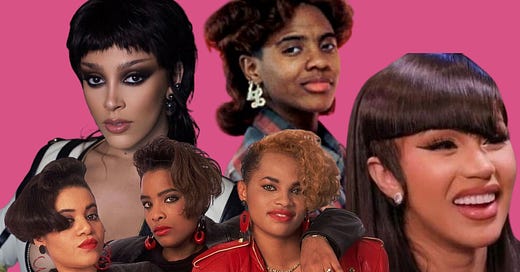During Kelela's Tiny Desk Concert, she rocked an asymmetrical Mary J. Blige-inspired hairstyle. Since then other celebrities like Cardi B and Jada Kingdom have debuted similar styles with slight variations in color and shape. The hairstyle typically features uneven bangs, tapered sides, and longer hair in the back than in the front. Recently, celebrity hairstylist Tokyo Stylez shared a blonde and an auburn lace wig version of the look on X. In response to Stylezs’ claim that she innovated the look, someone shared the image of Mary J. Blige to refute her claim.

While Stylez claims that both hairstyles are very different from one another, they are objectively similar. Michella Orè covered the trending style and cited Cardi B as its leading trendsetter in 2021. Orè described the style as “...giving avant-garde elegance with a rockstar twist and we're beyond here for it.” What Orè and Stylez leave out is hip-hop’s influence. Last month I wrote about the history of the relaxer, which included a discussion of Black women’s hair and style in the 1980s.
The 1980s ushered in a shift towards maximalist style and beauty. The Fashion Institute of Technology describes the 80s as ostentatious glamour and self-confident fashion were manifested in a variety of extravagant styles. Hip-hop, then about a decade old, experienced heightened coverage and further extended its influence. With increased exposure on shows like Video Music Box (1983) and Yo! MTV Raps (1984) rappers’ big hair, logo-embossed clothing, and huge chains revealed a convergence of luxury and maximalism that was unparalleled.
The adage, “the higher the hair, the closer to God,” illuminates 1980s approaches to hair. While the saying is often attributed to white women, Black women’s hair was also towering. From stacked cuts to bouncy mushrooms to triangular curly cuts, Black women’s hair was as flashy as our style. Salt-N-Pepa’s influence on Black women’s beauty culture, specifically their “stacked” haircuts, cannot be overstated.
Pictured below is an image of the trio rocking different versions of the same style. Pepa’s style is probably the most famous, as her style included a shaved side and blonde ends. Pepa revealed that her shaved side was the result of her sister accidentally burning her hair off with a relaxer. This style was also worn by other major 1980s hip-hop figures of the time like MC Lyte.

Hip-hop was only about a decade old at the time of the asymmetrical cut’s debut. The burgeoning genre was certainly unique, but it also reflected the influence of other popular music styles like Rock & Roll. Hip-hop was birthed in rebellion and like Rock & Roll’s commitment it expressed the sentiments of the counterculture.
Charles Aaron notes, “Though hip-hop may have been a party in the ruins of a bankrupt New York City, as evidenced by hit records like Sugarhill Gang’s 1979 “Rapper’s Delight,” it was still a revolt.” He goes on to trace the interconnectedness of “rap rock” and the differences in how their youthful rebellion was received by audiences. This youthful dissent from tradition was also defined by personal style and there is an interesting connection between hip hop's asymmetrical cuts and rock’s mullets.

Note: As has been widely explored, Black Americans founded Rock-n-Roll, so perhaps we might understand the style as coming full circle.
The hairstyle has evolved a great deal since its debut, however its key feature remains: trendsetting female rappers are the key to its continued resurgence and evolution. Today’s version of the style is more reminiscent of the classic rock mullet as it has much longer hair in the back, but the shaved sides and curled bangs give 80s hip-hop. Tutorials can be found on every social site. The differences between the style and its predecessors are both many and slight. Regardless of these differences, the prevalence of the unique hairstyle reflects Black women’s long history of taking risks with beauty and style and always coming out on top.




